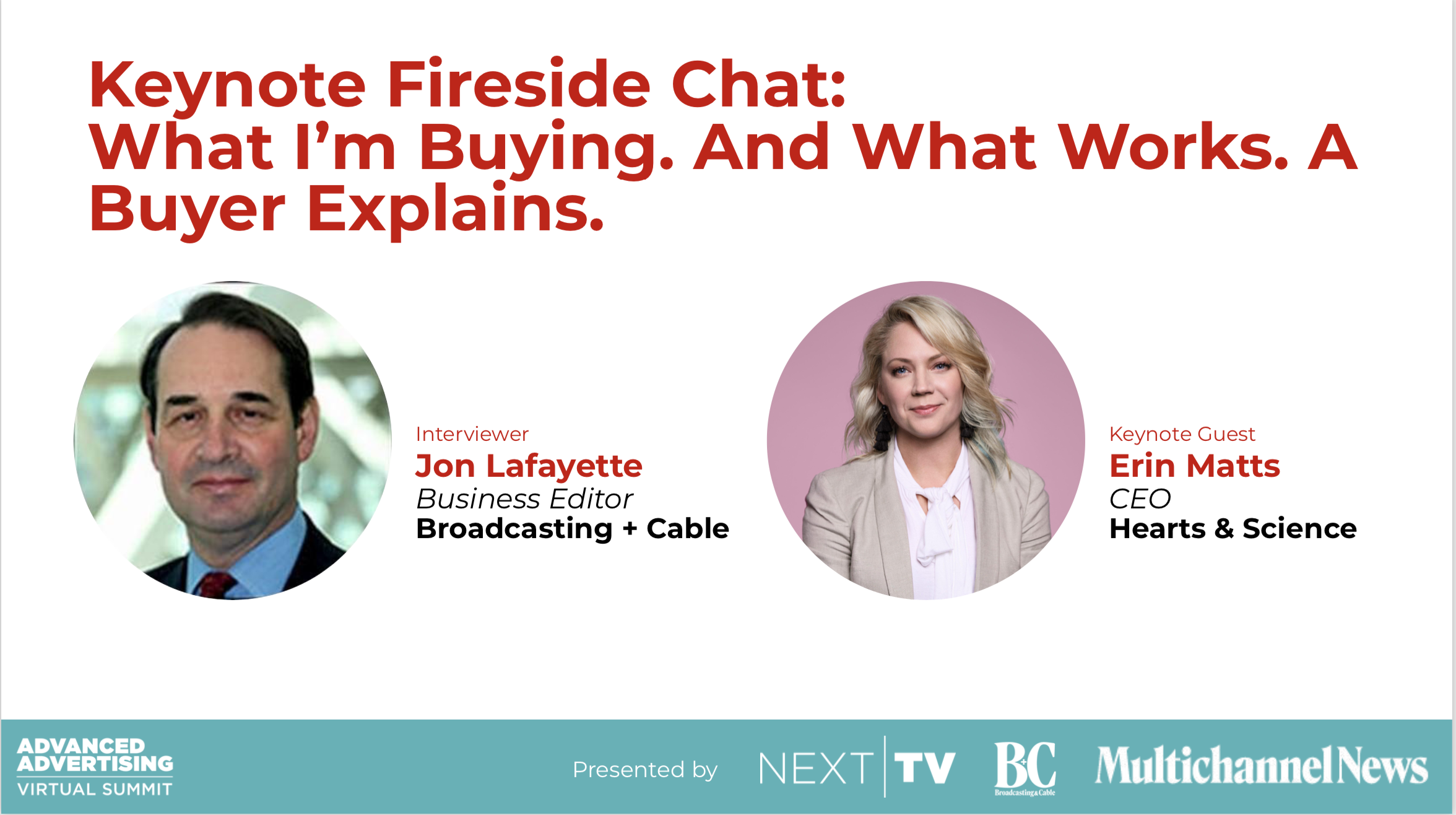Advanced Advertising: COVID-19 Presents Challenges, Opportunities
The ongoing COVID-19 pandemic has driven television and streaming content viewership to new highs, and at the same time is presenting ad buyers and sellers with data that could accelerate the shift from age and demographic-centered measurement to more individualized metrics, according to panelists at the Future-produced Advanced Advertising Virtual Summit Tuesday.
In a keynote discussion with event moderator and B+C senior content producer Jon Lafayette, Hearts & Science CEO Erin Matts said that audiences are shifting not only because they are at home, but also because of the availability of certain content.
Hearts & Science is a unit of Omnicom Media Group, which places about $1 of every $4 spent on sports programming for its clients, Matts said. As live sports has been virtually non-existent during the pandemic, agencies like Hearts & Minds need to seek out where those typical sports audiences are watching now.
Related: Experts See Opportunity for Targeting, AVOD Buys

And viewership is growing. According to Canoe VP of Global Sales Chris Pizzurro, on demand viewing is up 20%, primarily in the kids, drama and movie segments and that TV viewing as a whole is up during the pandemic.
“Consumers are definitely finding comfort in television as a whole,” Pizzurro said, adding that they also seem to be watching commercials as ad impressions seem to be even with last year. “We haven’t seen the dramatic declines other platforms have.”
The same holds true for streaming services, Matts added. While Hearts & Minds, like most agencies were geared up for the so-called streaming wars as new entrants in direct-to-consumer content distribution came on the scene, no one anticipated the huge spike in viewership as more and more Americans were confined to their homes.
Multichannel Newsletter
The smarter way to stay on top of the multichannel video marketplace. Sign up below.
Matts said that one of the priorities was to find where consumers were going if they weren’t watching sports. And she said while many are watching new programming on the streaming services, many have gravitated toward “comfort” programming, like old episodes of Friends and Seinfeld and even podcasts and other audio programming.

There is tremendous opportunity, she added in “understanding those audiences, understanding where time goes for them and how they are spending that time and being able to elegantly insert brands in a meaningful way that delivers the right kind of message that is appropriate for this moment in time.”
While some clients are buying ads in the scatter markets to find those wayward viewers, Matts said the pandemic and changing viewing habits could force the industry to take a harder look at how they traditionally sell ads.
“I think this is such an interesting opportunity to almost reframe how we think about the upfronts,” Matt said. “This has been a time honored tradition that we’ve had in this industry for a very long time, it's been extremely successful. But we’ve got clients who are on different timelines, we’ve got clients who have different needs and I think it gives us an opportunity to take a step back. Any sort of refresh to how we think about the industry is a welcome change, and one that honestly all of my clients have been welcoming themselves.”
More Summit Coverage: Experts See Opportunities for Targeting, AVOD; 'Last Dance' Shows Disney's Agility; Strategies For Smart Spending After Crisis
It also appears to be changing how advertisers are looking at their audiences, she said.
“Clients are much more willing to take some risks at this point,” Matts said. “It also brings this idea of audience and people-based approaches much more into focus and allows advertisers to really explore some things they haven’t been able to do before.”
Matts added that when the world and business emerge from the pandemic sometime in the future, the opportunity to focus on people rather than demographics will be more important than ever.
“Operating around audiences instead of the broad approach of demographics helps us to understand people at an individual level, helps us with empathy, helps us understand and better optimize messages and media,” Matts said. “It was important before all of this, but it is even more important right this very moment because we really need to understand what is motivating people and what is motivating them to buy or not buy at this moment, but will help us weather the storm beyond this.”
Addressable advertising is gaining scale, said Spectrum Reach Group VP of Advanced Advertising Sales Kim Norris in a separate panel discussion.

“In 2018 we executed dozens of addressable campaigns. In 2019 it was hundreds. I think that scale is growing,” Norris said, adding that standards and common platforms and approaches are needed to take advantage of that scale.
She added that buyers and sellers are working together to reach that goal.
“There is more collaboration now than I have ever seen,” Norris said. “All of that collaboration between programmers, MVPDs, ad tech companies, data companies have really pushed forward the advances. I think the scale is there for this to now be a viable business -- I think we see it in the activity. And now we need these organizations to coalesce so that we can actually create the standards so that there are use cases and approaches for the advertisers and agency holding companies to really follow. ”
FuboTV VP ad sales Chris Flatley said that while stay-at-home orders have helped drive content viewership “through the roof,” he doesn’t believe the disruption caused by the pandemic will change how advertisers are buying.
“When you look at advertisers, they’re either buying addressable or they’re not buying addressable,” Flatley said. “I don’t think COVID-19 is really going to impact that. What’s really happening is, ‘Are they buying at all right now?’ If they are, they’re buying the way they’ve always been, whether that’s addressable or run of network.”
As an example, he pointed to an addressable client that sells products that sanitizes surfaces, which would appear to be even more widely popular during the pandemic.
“They keep buying addressable,” Flatley said of the client. “I think when you look at how the advertiser thinks, they still know who their buyer is and who the decision maker is. I think the current environment doesn’t change whether someone is buying addressable or not. Whether they’re buying or not is what we’re waiting on as we climb back up the hill.”
But as more and more networks become addressable nationally, there is a need to figure out how addressable fits into their other advertising tactics.
Clypd chief strategy officer Jason Burke said that addressable is really just another tactic for advertisers, and most don’t want to put all their marketing eggs in one basket. One tactic is to use addressable alongside linear ads, using it to tell a story, a second chapter in the message, via addressable ads.
“The media owners are looking to use addressability to do a handful of things,” Burke said. “One is to drive yield across their whole portfolio, potentially using addressability to deliver against audiences that are underperforming in other environments and really deliver to the consumer a great experience, and then its relevant advertising, or advertising that is targeted to them as an individual person, versus the broad demographic in which they reside.”
Measurement giant Nielsen unveiled plans to beta test its linear TV addressable platform in January, and Nielsen Advanced Video Advertising Group general manager Kelly Abcarian said that while some changes had to be made because of COVID-19, the project is going forward.
“Much like everyone else, we’ve had to spend some time to adapt our beta program to the changing times that we see ourselves in,” Abcarian said. “...Though our beta program may not look like what we originally envisioned, we are moving forward with the beta.”
She added that originally, the first phase of the test involved getting into its partners’ facilities on premises and installing two TV sets.
“Obviously given the safety concerns and societal restrictions, we are no longer able to work on the premises,” Abcarian said. “We had to get creative, and what we’ve done is introduce a new virtual experience. That’s going to enable mimicking what they would have done on premises, but doing it via a virtual environment.
“...They’ll get access to be able to look at the true ad replacements that are happening, so that they can feel confident before this capability goes out in front of real viewers,” Abcarian continued. “And they can also use our UI so they can create inventory rules much like they do in linear television today whether that’s brand separation or other types of rules and see those rules in action. And make sure that they have the confidence that they know how they are going to unlock this linear inventory as we move ahead toward commercialization.”
